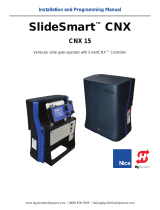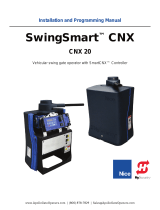Page is loading ...

100909 Linear /OSCO Page 1
pn 888-1505-001 19 Railroad Avenue, Casnovia, MI 49318
Tel: 800-333-1717 Web: www.operatorspecialty.com
Model 2500-2346-LP
Operating Instructions
Plug-in Vehicle Loop Detector
Single Channel – Dual Solid State Outputs
General/Overview:
The Linear / Osco Model 2500-2346-LP operates on 12 VDC, 24 VDC, and 24 VAC, and is designed for low power requirements. The detector is
designed to handle gate, parking, drive-through, and all access control applications where solid-state outputs are required for both the “detect and
“fail” outputs. From a diagnostic standpoint, the Model 2500-2346-LP automatically and continuously senses three (3) types of possible loop fault
conditions: Open Loop(s), Shorted Loop(s), sudden changes in inductance exceeding 25% of the nominal inductance. The Model 2500-2346-LP also
displays the frequency of the loop upon power up. Immediately after applying power, the unit displays 2 or 3 numbers quickly flashing (values
between 13 and 150 kilohertz) before the DEFLECTOMETER resets to zero. This allows you to measure and separate the frequency of each
detector loop. The detector frequency should be adjusted so that there is a minimum of 5 kilohertz of separation between all adjacent loops.
The front panel DEFLECTOMETER display is active for 2 minutes following power-up or after any button press. This adds approximately 10 mA to
the current draw.
Setting Sensitivity:
Dip Switch Functions:
Dip Switch 1 & 2 – Frequency: The operating frequency is controlled by the setting of switches 1 & 2 of the 8 position DIP Switch. Occasionally
when loops are in close proximity to each other, it may be necessary to select different frequencies for each loop detector to avoid loop interference
(crosstalk). The actual loop frequency is a function of the size of the loop, number of turns of loop wire in the loop, length of the lead-in cable, and the
setting of the frequency switches. When power is applied to the detector, the operating frequency (between 13 and 150 kilohertz) is displayed on the
front panel 7-segment LED (2 or 3 numbers will quickly flash before the DEFLECTOMETER goes to zero) allowing you to measure the frequency of
each detector/loop. The detector frequency should be adjusted so that there is a minimum of 5 kilohertz of separation between all adjacent loops.
Dip Switch 3 – Fail-Safe / Fail-Secure Operation: Either Fail-Safe or Fail-Secure Operation is controlled by the setting of switch 3 of the 8 position
The DEFLECTOMETER (front panel 7-segment LED) aids in setting the detector to the most optimum sensitivity level to help
ensure the detection of all vehicles, including motorcycles and high bed vehicles.
For typical vehicles (mid-size vehicle / small pick up) utilizing properly installed roadway loops, when the number 4, 5, or 6
(5 being optimum) is displayed on the DEFLECTOMETER during the DETECT output period then the sensitivity is set correctly.
For high profile vehicles (commercial trucks, 4x4’s, etc…), DEFLECTOMETER reading 3 or 4 will be best. For low profile vehicles
(sports cars, etc…), DEFLECTOMETER reading 6 or 7 will be best.
Adjusting sensitivity utilizing the DEFLECTOMETER:
The DEFLECTOMETER should read zero (0) with no vehicle over the roadway loop.
If a mid-size vehicle, located over the roadway loop causes the number “7” to be displayed on the DEFLECTOMETER, you need
to lower the sensitivity two levels (7 – 2 = DEFLECTOMETER reading 5). This can be done by pressing the front panel SENS
(down) push button twice.
If a mid-size vehicle, located over the roadway loop causes the number “2” to be displayed on the DEFLECTOMETER, you need
to add three sensitivity levels (2 + 3 = DEFLECTOMETER reading “5”. This can be done by pressing the front panel SENS (up)
push button 3 times.
Another great feature to note is that the sensitivity dynamically updates after each push button position change, allowing you to
change sensitivity settings while a vehicle is over the loop zone.
Adjusting sensitivity without using the DEFLECTOMETER (Manually set Sensitivity):
The Model 2500-2346-LP offers 10 levels of sensitivity (0 to 9). This can be manually set to any desired level by pressing the
SENS or SENS front panel push buttons when a vehicle is NOT over the roadway loop. The sensitivity level will be displayed
on the 7-segment LED. The factory default is level 4. Pressing the SENS or SENS switch once will display the sensitivity
without changing the setting. After pressing the SENS or SENS switches to display the sensitivity, the sensitivity can be
changed by pressing the SENS or SENS switches again. The display will automatically return to the normal display after
several seconds.

100909 Linear /OSCO Page 2
pn 888-1505-001 19 Railroad Avenue, Casnovia, MI 49318
Tel: 800-333-1717 Web: www.operatorspecialty.com
DIP Switch. The default position is Fail-Safe (switch 3 in the OFF position). If a loop fault occurs while in the Fail-Safe mode, Output A activates. If a
loop fault occurs in the Fail-Secure mode (switch 3 is in the ON position) Output A will not activate.
Dip Switch 4 & 5 – Output “B” Modes (pin 6): Output B has 4 selectable output modes: Loop Fault, B same as A, Pulse on Exit, Pulse on Entry.
For Loop Fault Mode, if the loop fails the Output B will conduct indicating the failure. For either Pulse on Entry or Pulse on Exit a 250 millisecond
pulse is generated on Output B. The default position is set to Loop Fault (switch 4 = 0FF & switch 5 = OFF).
SWITCH Loop Fault B same as A Pulse On Exit Pulse On Entry
4 0FF ON OFF ON
5
0FF
OFF
ON
ON
Dip Switch 6 – Delay Timing: The default position is set to OFF. When switch 6 is in the ON position, a 2-second “detect” delay feature will delay
outputs A & B for a period of 2 seconds after a vehicle has entered the detection zone. Note that the DEFLECTOMETER will display the letter “d” for
“Delay Time”. If the vehicle does not remain in the loop zone for the full 2 seconds the delay will terminate and no DETECT output will be produced.
Dip Switch 7 – Output “A” Modes: Output A has 2 selectable output modes: Infinite Presence and Normal Presence. The default position is Infinite
Presence (switch 7 = OFF). In the Infinite Presence mode, a presence output will always be maintained as long as a vehicle is over the loop and
power is not removed for more than approximately 3 seconds. In the Normal Presence mode (switch 7 = ON), the output hold time is between 5
minutes minimum and 3 hours maximum. Hold time depends on loop geometry; number of wire turns in the loop, vehicle size, and position of the
vehicle relative to the loop.
Dip Switch 8 – Sensitivity Boost: The default position is set to OFF. When switch 8 is in the ON position and when a vehicle enters the loop zone,
the detector sensitivity is boosted to a higher level than the vacant loop setting. The boosted sensitivity remains throughout the DETECT period.
When the vehicle leaves the loop zone, the sensitivity returns to the vacant loop setting. This feature is designed to automatically increase sensitivity
only during the DETECT output period. This feature aids in preventing dropouts during the passage of high bed vehicles and is particularly useful in
sliding gate situations.
Detector Diagnostics: The detector continuously checks the integrity of the loop. The system is able to detect open or shorted circuit loops, or
sudden changes in inductance exceeding 25% of the nominal inductance. If a fault is detected, the POWER and DETECT LED’s continuously emit a
sequence of flashes. Additionally, the 7-Segment DEFLECTOMETER displays the letter “F” indicating a current loop fault. Each type of fault is
identified by a different flash sequence:
Flash Sequence
Fault
1 flash Open Circuit Loop.
2 flashes Shorted Circuit Loop.
3 flashes 25% excessive change in inductance.
If the Open or Shorted fault condition self heals, the DETECT LED and 7-Segment DEFLECTOMETER will return to normal operation. Only the
POWER LED will continue to flash with the sequence signifying the type of fault that was last detected. In the case of the excessive inductance
change fault, the unit will retune to the new inductance after a period of two seconds and continue operation. The fault condition will be indicated by
the flash sequence of the POWER LED. Pressing the “Reset” button will reset the detector and clear the flash sequence from the DETECT LED. If
you want to review the last loop fault condition, simply press and hold the “Reset” button for 2 seconds and the DETECT LED will display the
previous loop fault condition.
Pin Assignments:
Pin
Function Pin Function
1 Loop 6 Output B
2 Loop 7 Output B Inverted
3 Power (12-24VDC, 24VAC) 8 Output A (Presence Output)
4 No Connection 9 Power (12-24VDC, 24VAC)
5 No Connection 10 Common
Note: Power may be applied on either pin 3 or 9, or both
Environmental:
Operating Temperature Range: -34
o
C to +74
o
C (-30
o
F to 165
o
F)
Humidity Range: 0 to 95% relative.
Mechanical:
Dimensions: 2.30” (5.84 cm.) high x 2.75” (6.98 cm.) wide x 0.80” (2.03 cm.) thick
Weight: 1.50 oz. (42 g.)
Power Supply:
10 to 30 VDC or 14 to 26 VAC
8 mA maximum in No Call state.
9 mA maximum in Call state.
/

![Eberle DesignDeflectometer Inductive Loop Monitor [LMD602, LMD602T, LMD604,LMD604T]](http://vs1.manuzoid.com/store/data/001476625_2-352a61b560d4fc181793a55d495056b5-160x210.png)


